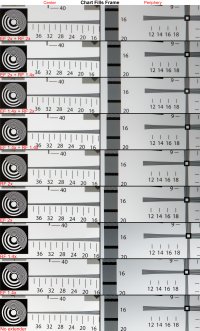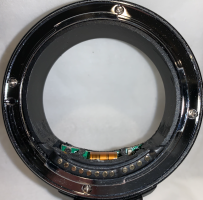After getting both the RF extenders to use with my RF 100-500L, I became curious about whether they would perform better than my EF MkIII extenders when used with my EF 600/4L IS II on my EOS R3. As most will know, the protruding elements of the RF extenders do not fit into the Canon EF-RF mount adapters, even the drop-in filter version that has a much wider opening. I purchased a Commlite EF-RF adapter (which has a wider opening than the other 3rd party adapters or the OEM versions), and modified it with a Dremel until the opening was sufficiently wide to accept the TCs.
The resolution charts on The Digital Picture allow comparison of the EF TCs on the EF 600/4 III with the RF TCs on the RF 600/4, but they are done with two different bodies, and that complicates interpretation. With the modified adapter in hand, I had the ability to test both sets of adapters with the same lens. Of course, being able to mount the EF TCs in front of the adapter and the RF TCs behind the adapter gave me the opportunity to test the various combinations of stacked TCs as well, which I did.
I did two sets of tests with all 8 possible combinations of TCs and the bare lens, all at the lens' maximum aperture:
Below are the first set of results. I cropped larger regions than Bryan does (about double the size). The image below is scaled down for upload here, the full size version that shows 1:1 crops can be viewed HERE.

The second set of tests were a more 'real world' approach similar to that used here by @AlanF to test lenses and extenders. For those tests, the distance was kept constant, which is more relevant for something like bird photography where you can only get so close to the subject and must rely on extenders and/or cropping. For these tests, the distance was ~10 m / 33', which was the distance needed to fully frame the smallest test chart (~150 x 100mm). The image below is scaled down for upload here, the full size version that shows 1:1 crops can be viewed HERE.

As expected, stacking two extenders results in a loss of sharpness. However, the 4x magnification increase with the stacked 2x TCs results in about 3x the resolving power of the bare lens. It will be interesting to see how that translates into real-world subjects that benefit from higher magnification, the moon for example.
Looking at comparisons more relevant for everyday use, the EF and RF 1.4x TCs deliver very similar performance. The EF version appears very slightly sharper in the center, the edges are equivalent. There is a noticeable difference between the EF and RF 2x TCs on the EF 600/4 II, with the EF 2xIII delivering sharper results in the center and periphery. The RF 2x actually performs pretty much identically to the two 1.4x TCs stacked (which yields the same final 2x magnification as the 2x TC). Also, though it's not evident from the crops, the RF 2x introduces a noticeable level of barrel distortion that the EF 2x does not. I wonder if that's in keeping with Canon's other RF lenses that leave substantial barrel distortion in the optical design in favor of digital correction (note that I would not consider the RF 2x to have substantial distortion, but it is evident).
For my personal use, I'll stick with the EF TCs when using the EF 600/4 II on my R3, possibly with the RF 2x added behind the EF 2x when I want the maximum focal length I can achieve.
The resolution charts on The Digital Picture allow comparison of the EF TCs on the EF 600/4 III with the RF TCs on the RF 600/4, but they are done with two different bodies, and that complicates interpretation. With the modified adapter in hand, I had the ability to test both sets of adapters with the same lens. Of course, being able to mount the EF TCs in front of the adapter and the RF TCs behind the adapter gave me the opportunity to test the various combinations of stacked TCs as well, which I did.
I did two sets of tests with all 8 possible combinations of TCs and the bare lens, all at the lens' maximum aperture:
- EF 2xIII + RF 2x + EF 600/4 II = 2400mm f/16
- EF 2xIII + RF 1.4x + EF 600/4 II = 1680mm f/11
- EF 1.4xIII + RF 2x + EF 600/4 II = 1680mm f/11
- EF 1.4xIII + RF 1.4x + EF 600/4 II = 1200mm f/8
- RF 2xIII + EF 600/4 II = 1200mm f/8
- EF 2xIII + EF 600/4 II = 1200mm f/8
- RF 1.4xIII + EF 600/4 II = 840mm f/5.6
- EF 1.4xIII + EF 600/4 II = 840mm f/5.6
- EF 600/4 II = 600mm f/4
Below are the first set of results. I cropped larger regions than Bryan does (about double the size). The image below is scaled down for upload here, the full size version that shows 1:1 crops can be viewed HERE.

The second set of tests were a more 'real world' approach similar to that used here by @AlanF to test lenses and extenders. For those tests, the distance was kept constant, which is more relevant for something like bird photography where you can only get so close to the subject and must rely on extenders and/or cropping. For these tests, the distance was ~10 m / 33', which was the distance needed to fully frame the smallest test chart (~150 x 100mm). The image below is scaled down for upload here, the full size version that shows 1:1 crops can be viewed HERE.

As expected, stacking two extenders results in a loss of sharpness. However, the 4x magnification increase with the stacked 2x TCs results in about 3x the resolving power of the bare lens. It will be interesting to see how that translates into real-world subjects that benefit from higher magnification, the moon for example.
Looking at comparisons more relevant for everyday use, the EF and RF 1.4x TCs deliver very similar performance. The EF version appears very slightly sharper in the center, the edges are equivalent. There is a noticeable difference between the EF and RF 2x TCs on the EF 600/4 II, with the EF 2xIII delivering sharper results in the center and periphery. The RF 2x actually performs pretty much identically to the two 1.4x TCs stacked (which yields the same final 2x magnification as the 2x TC). Also, though it's not evident from the crops, the RF 2x introduces a noticeable level of barrel distortion that the EF 2x does not. I wonder if that's in keeping with Canon's other RF lenses that leave substantial barrel distortion in the optical design in favor of digital correction (note that I would not consider the RF 2x to have substantial distortion, but it is evident).
For my personal use, I'll stick with the EF TCs when using the EF 600/4 II on my R3, possibly with the RF 2x added behind the EF 2x when I want the maximum focal length I can achieve.


